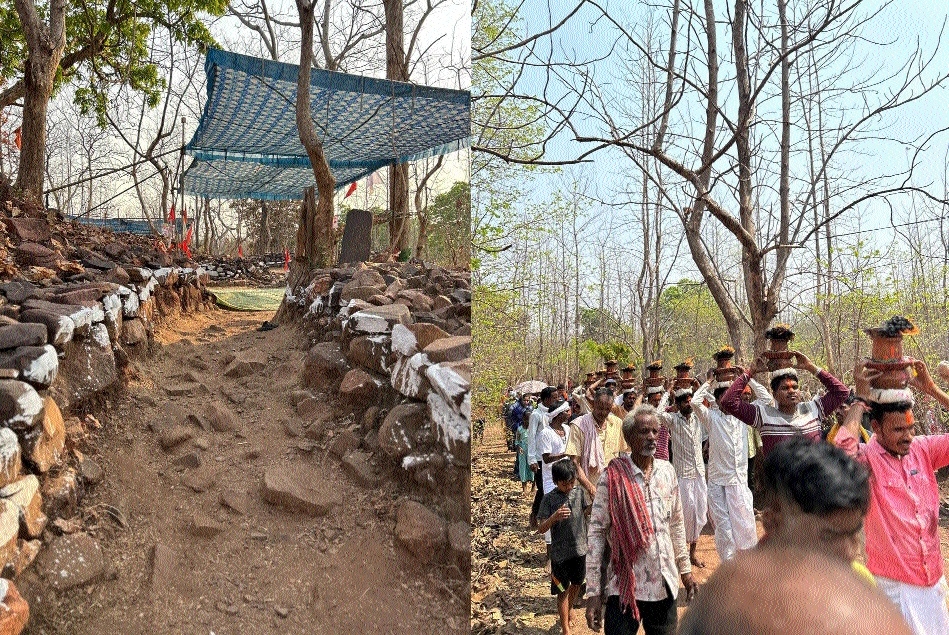Bhanwardah: Khairagarh’s enchanting shrine to Bhramari Devi, the bee goddess
| Date :21-Apr-2025 |

By Roshan Chachane :
RAIPUR
Nestled within the verdant embrace of Khairagarh district, lies Bhanwardah, a captivating spiritual haven resonating with centuries of history and cultural significance. Situated a short distance from Gandai, this unique site dedicated to Maa Bhramari Devi, the goddess revered as the deity of bees, is tucked away in dense forests, cradled between the majestic Maikal hills and the serene Surhi river.
Local scribe, Amit Pandey told The Hitavada that the remarkable characteristic of Bhanwardah is its unconventional temple. Instead of an imposing structure, Maa Bhramari Devi is believed to reside beneath a sacred peepal tree, her presence marked by the thousands of beehives that naturally flourish in her sacred precinct. This extraordinary spectacle often moves first-time visitors deeply, with local devotees perceiving these buzzing insects as the living manifestation of the divine mother.
According to ancient beliefs, when demonic forces threatened the earth, the goddess manifested countless bees from her own form to vanquish them, thus earning the epithet Bhramari Devi. The myriad beehives that thrive at this site serve as a constant testament to this enduring mythological narrative.
Local lore, supported by historians, speaks of a grand temple that graced this location in the 10th century, a place of worship for the kings of the Gandai Zamindari. Legend recounts that the king would approach the goddess’s abode bearing his double-edged sword, and upon its sight, the Surhi river would miraculously part to allow his passage. However, one day, the king inadvertently left his sword behind after his prayers. From that moment onward, the river never yielded again, and gradually, the once-grand temple vanished.
Even today, tangible evidence of Bhanwardah’s rich past can be observed in the vicinity of the sacred tree, including inscriptions, fragmented statues, and weathered stone blocks dating back to the 10th century.
These archaeological remnants stand as silent witnesses to the historical prosperity of this place. Bhanwardah’s charm lies in its
unpretentious nature. Devoid of towering spires or ornate silver doors, it is simply a tree sheltering the revered goddess. This very simplicity is the essence of Bhanwardah’s unique spiritual allure.
A distinctive annual tradition unfolds after Navratri, with a special nine-day celebration dedicated to the goddess, during which an ‘akhand jyot’ (eternal flame) is kindled. This practice has been faithfully observed for the past 17 years. On the concluding day, these flames, which have burned for nine days, are ceremonially immersed in the Surhi river amidst sacred rituals of havan and puja.
Raja Lal Tarkeshwar Khusro of the Gandai royal family has expressed plans for the future renovation of Maa Bhramari’s sacred ground, including the construction of a grand temple to ensure the enhanced preservation of this significant center of faith.
Reaching Bhanwardah entails a journey of approximately 2-3 kilometers from Gandai via the Bhadbhadi Dam, traversing footpaths and unpaved trails, and involving two river crossings. However, the arrival at the tranquil sanctuary of Maa Bhramari transforms this arduous trek into a profound spiritual experience. Bhanwardah transcends being merely a religious site; it serves as a starting point for an inner journey, where devotion, nature’s beauty, and history intertwine. For those seeking a deeper connection, Bhanwardah awaits, where reverence speaks in the stillness, and the divine presence of the mother is palpable in the gentle hum of the bees.
